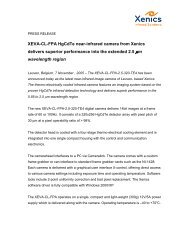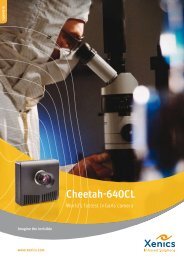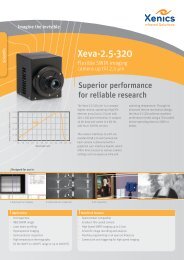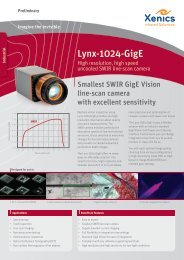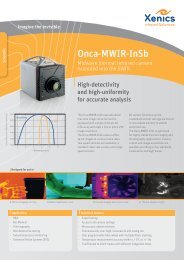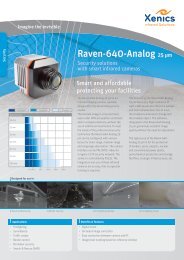Download here the full press release - XenICs
Download here the full press release - XenICs
Download here the full press release - XenICs
You also want an ePaper? Increase the reach of your titles
YUMPU automatically turns print PDFs into web optimized ePapers that Google loves.
Xenics PR SPIE DSS 2011 show announcement<br />
FOR IMMEDIATE RELEASE<br />
2011<br />
SPIE DSS 2011<br />
25. – 29. April<br />
Orlando, FL, USA<br />
Gearing up for SPIE DSS 2011:<br />
Xenics presents ready-to-integrate OEM modules for shortwave and<br />
<strong>the</strong>rmal imaging and <strong>the</strong> latest technology developments in true image<br />
fusion<br />
Leuven, Belgium / Orlando, FL, 24.04.2011 --- Xenics, Europe's leading developer and<br />
manufacturer of advanced infrared detector solutions, is proving <strong>the</strong> breadth of its innovation<br />
and production capabilities. At SPIE DSS 2011, Xenics will introduce “XenicsCores”, a new<br />
family of compact, high resolution infrared OEM modules as well as image fusion technology<br />
from different spectral ranges. Xenics will also demonstrate <strong>the</strong> latest upgrades of <strong>the</strong>ir<br />
proven products: GigE-Vision upgrade for Gobi-640, ThermographyStudio software for all<br />
MWIR to LWIR cameras, longwave <strong>the</strong>rmal imaging with Onca-640, <strong>the</strong> smallest TE-4<br />
cooled SWIR camera Xeva-2.5-320 at 200 Hz and new options for <strong>the</strong> high-speed Cheetah-<br />
640CL. Xenics exhibits in Palms Hall, Booth # 3119.<br />
OEM modules and components<br />
Up to now Xenics is well known for its in-house developed InGaAs infrared detectors with<br />
wide dynamic range and <strong>the</strong>ir versatile and compact camera systems. Xenics has chosen<br />
SPIE DSS for <strong>the</strong> presentation of a new family in between: Uncooled OEM modules as<br />
extremely compact and versatile cores which are ready to be integrated in <strong>the</strong> customer’s<br />
application and consume only low power.<br />
The universal QTE connector allows for easy integration and offers <strong>the</strong> <strong>full</strong> flexibility to<br />
choose <strong>the</strong> preferred interface. This highlights <strong>the</strong> outstanding flexibility and cost-effectively
solution of Xenics. The first two types are XSW-640 (Xenics Short Wave module) and XTM-<br />
640 (Xenics Thermal Module).<br />
The XSW-640 camera module measures only 45 x 45 x 20 mm³ and is based on an<br />
uncooled InGaAs array (640 x 512 pixels) with 20 µm pixel pitch for <strong>the</strong> detection of short<br />
wave infrared radiation between 0.9 and 1.7 µm. The resolution of <strong>the</strong> analog/digital<br />
converter is 14 bit.<br />
The XTM-640 or Xenics Thermal Module is optimised for <strong>the</strong> detection of <strong>the</strong>rmal infrared<br />
radiation between 8 and 14 µm. It is equipped with an uncooled microbolometer array of 640<br />
by 480 pixels with 17 µm pixel pitch with <strong>the</strong>rmal sensitivity of 50 mK. It measures only 45 x<br />
45 x 32 mm³, including advanced shutter design for optimal image performance in a small<br />
form factor housing,<br />
Both modules need only 2.0 W from <strong>the</strong> 3.3 V supply and feature a frame rate of 50 Hz.<br />
Trigger input and output are available for synchronisation with external sources. Via its<br />
powerful readout and processing electronics, advanced NUC and image processing<br />
algorithms guarantee unparalleled uniform and crisp <strong>the</strong>rmal images over a wide range of<br />
dynamic environments. The opto-mechanical design of <strong>the</strong> XenicsCores is adapted to<br />
accommodate customer specific lens and interface requirements.<br />
Image fusion<br />
One of <strong>the</strong> latest technology trends is a combination of images, acquired in two different<br />
spectral ranges. The fusion of visual and SWIR or LWIR imaging or alternatively SWIR and<br />
LWIR enhances <strong>the</strong> vision of a scene and can set <strong>the</strong>rmal accents in SWIR or visual images.<br />
For this purpose <strong>the</strong> Meerkat Fusion camera is equipped with three cameras for <strong>the</strong> visual,<br />
SWIR and LWIR spectral ranges and unites <strong>the</strong> best of all worlds. Convenient software<br />
performs <strong>the</strong> image fusion of two cameras taking into account different resolutions of <strong>the</strong><br />
sensor arrays and different focal lengths of <strong>the</strong> optics. It delivers a picture that is segmented<br />
into regions using specific properties such as movement or high temperature. T<strong>here</strong>fore<br />
image fusion is well suited for early detection of wildlife fires and indoor search and rescue<br />
operations.
Security products<br />
The Meerkat camera series are high performance but affordable infrared camera solutions<br />
for demanding international security communities. The plug-and-play IR camera<br />
configurations cover all <strong>the</strong> regions of <strong>the</strong> infrared spectrum: Shortwave Infrared (SWIR),<br />
Midwave infrared (MWIR), Longwave Infrared (LWIR) and Very Longwave Infrared (VLWIR).<br />
The Meerkat Fix for example is a powerful surveillance and monitoring camera in a fixed<br />
housing with an uncooled LWIR <strong>the</strong>rmal imager. This complete system can be installed very<br />
easily with generic E<strong>the</strong>rnet connection in a local area network (LAN).<br />
For powerful and multi-purpose airborne imaging platforms <strong>the</strong> Pumair-170DW (Dual<br />
Wavelength) is equipped with two state-of-<strong>the</strong>-art infrared cameras: a longwave (LWIR) and<br />
a shortwave (SWIR) camera in one of <strong>the</strong> smallest lightweight housings on <strong>the</strong> market. Its<br />
two-axis gyro stabilized (better than 100 microRad) mini-gimbal comes in a revolutionary<br />
L-shape design for easy integration and low power consumption.<br />
Upgrades of proven products<br />
The features of proven products are continuously improved. Here are some examples:<br />
Gobi-640-GigE<br />
The uncooled <strong>the</strong>rmal camera Gobi-640 is now also available with a GigE Vision interface,<br />
which opens this high-resolution (640 x 480 pixels) camera to new application areas. It<br />
operates in <strong>the</strong> 8-to-14 µm wavelength range and detects temperature differences as small<br />
as 0.05 ºC.<br />
ThermographyStudio<br />
ThermographyStudio is a complete <strong>the</strong>rmal analysis software suite with realtime recorder<br />
function and powerful built-in measurement and analysis functions for all MWIR and (V)LWIR<br />
cameras like automatic hot spot detection, multi point trend, box-line trend, area trend,<br />
iso<strong>the</strong>rms, histograms, envelope profiles, line profiles, region-of-interest statistics and many<br />
more. Its clearly-structured and easy-to-use user interface allows intuitive usage of <strong>the</strong><br />
software and reduces training needs and costs. Professional and easy to read reports are<br />
created by a few mouse-clicks. ThermographyStudio will be demonstrated on <strong>the</strong> Gobi-384,<br />
a smart uncooled microbolometer camera for <strong>the</strong>rmal imaging in <strong>the</strong> LWIR range.
Onca extended into (V)LWIR<br />
The high-end IR and <strong>the</strong>rmal imaging platform Onca with cooled detector is excellently<br />
suited for R&D environments as well as industrial process monitoring, high speed imaging,<br />
target signature radiometric data collection, tracking and IR spectroscopy. The various<br />
sensor types MWIR-InSb, MWIR-MCT, LWIR-QWIP and LWIR-MCT cover extended<br />
wavelengths at a broad sensitivity range. The Onca-(V)LWIR-MCT is a Long to Very<br />
Longwave <strong>the</strong>rmal camera for special applications requiring longer wavelengths and extra<br />
spectral response filters. On <strong>the</strong> o<strong>the</strong>r hand <strong>the</strong> Onca-LWIR-QWIP camera excels in harsh<br />
environments with sharp and stable operation for long range imaging.<br />
Xeva-2.5-320 (MCT)<br />
The smallest TE-4 cooled SWIR camera is now available in a 200 Hz upgrade version. It<br />
delivers superior performance for reliable research tasks, allowing faster hyperspectral<br />
imaging at frame rates of 60, 100 or 200 Hz.<br />
Cheetah-640CL<br />
The Cheetah-640CL camera is now available in a three-stage water-cooled upgrade for <strong>the</strong><br />
120 Hz version. Cheetah-640CL TE3 offers high resolution, compact build and a dedicated<br />
low-noise InGaAs detector array for 0.9 to 1.7 µm. The TE3 cooled sensor and <strong>the</strong> water<br />
cooled camera head make <strong>the</strong> Cheetah-640CL TE3 highly sensitive, achieving ultra-low dark<br />
current characteristics at long integration times to operate at low light levels in <strong>the</strong> SWIR<br />
range, as needed in semiconductor failure analysis or luminescence spectroscopy.<br />
Conference contributions<br />
At <strong>the</strong> SPIE DSS conference two papers will be presented highlighting Xenics’<br />
expertise in image fusion with <strong>the</strong> Meerkat Fusion and fast line scan detectors with<br />
high resolution:<br />
The development of a multiband system for early detection of wildlife fires and indoor search<br />
and rescue operations<br />
Conference 8029A, Tuesday, 26. April 2011, 5:20 PM – 5:40 PM<br />
In <strong>the</strong> framework of <strong>the</strong> EU Firesense project (FP7-244088), several visible and infrared<br />
cameras are tested for <strong>the</strong> early detection of wildfires and to enhance <strong>the</strong> vision through<br />
smoke in indoor applications (e.g. parking lot fires). Images and detection are based on
oadband imagery, as well as on imaging of narrow band features. This work includes as<br />
well <strong>the</strong> sensor fusion to combine images from multiple wavelength bands and <strong>the</strong><br />
algorithms applied for <strong>the</strong> image segmentation and automatic fire and smoke detection.<br />
A 40 ksamples/sec spectrometer based FBG interrogator, capable of simultaneously<br />
measuring more than 16 FBG sensors.<br />
Conference 8028, Thursday, 28. April 2011, 4:20 PM – 4:40 PM<br />
A fast spectrometer based FBG interrogator will be discussed. This unit is constructed<br />
around a fast linear InGaAs array with 1024 pixels and capable of reading out 40 000 lines<br />
per second. This array is integrated in a double reflective grating spectrometer, dispersing<br />
<strong>the</strong> spectra in <strong>the</strong> [1510 – 1590 nm] band. The signal treatment electronics is capable of<br />
determining <strong>the</strong> peak wavelength position of at least 8 birefringed FBG sensors or 16 single<br />
FBG sensors at <strong>the</strong> data rate, supplied by <strong>the</strong> image sensor.<br />
About Xenics<br />
Xenics is a leading developer of innovative infrared detection solutions for a wide range of<br />
applications. Xenics designs, manufactures and sells infrared detectors, modules and<br />
cameras, both line-scan and 2D, covering <strong>the</strong> infrared wavelength ranges from 0.4 to 14<br />
micrometers. In addition, Xenics delivers custom products according to <strong>the</strong> agreed<br />
specification and planning. As a European vendor with a worldwide service and distributor<br />
network, Xenics is strategically placed to serve global markets with highly innovative<br />
products drawing on a strong science and technology background.<br />
Xenics Media Contact<br />
Myriam Gillisjans, Marketing<br />
Xenics, Ambachtenlaan 44, 3001 Leuven, Belgium<br />
Tel.: +32 16 38 99 00, Fax: +32 16 38 99 01<br />
E-mail: myriam.gillisjans@xenics.com<br />
www.xenics.com




